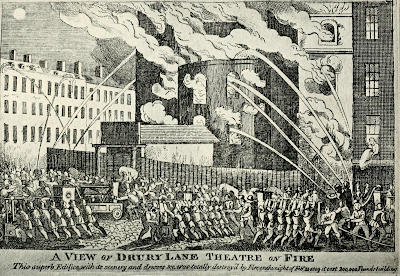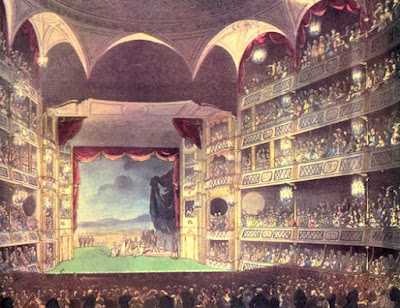 |
| Drury lane Theatre on fire from Shakspere to Sheridan - a book about the theatre of yesterday and today by A Thaler (1922) |
When did Drury Lane Theatre burn down?
Feltham’s The Picture of London for 1818 said:
On the twenty-fourth of February [1809], about eleven o'clock at night, the superb theatre of Drury Lane was discovered to be on fire, and though such a vast building, it was entirely consumed by four o'clock on the following morning.1
How did Drury Lane Theatre burn down?
According to Mrs Cornwell Baron Wilson’s Memoirs of Miss Mellon:
A fire had been left in the upper coffee-room at four in the afternoon, and there being no performance, all the servants were out of that part of the theatre; it is supposed that it ignited and caught the wood-work.2
The Picture of London for 1810 stated:
At a quarter after 11 o’clock at night, Feb 24, 1809, this splendid Theatre, the most magnificent perhaps in Europe, was enveloped in flames, and in less than one hour and an half the whole was an immense heap of ruins … In less than a quarter of an hour from the first discovery of it, the fire spread in one unbroken flame over the whole of the immense building, extending from Brydges-street to Drury-lane, and displaying a pillar of fire not less than 450 feet in breadth. The rapidity of the flames was such, that before twelve o'clock the whole of the interior from the extremity of the boxes in Brydges-street to the back of the stage, including a newly-erected building for the scenes, was in one tremendous blaze. Neither the burning of the Opera House, nor of Covent-garden, nor the late fire at St James’s, can be compared in terrific grandeur with this dreadful conflagration.3
Some questioned whether the fire was an accident, judging it unlikely that rival theatres should have burnt down in such a short space of time. Boaden wrote in his Memoirs of Mrs Siddons (1827):
So speedy a coincidence, as it defied the doctrine of chances, and the probabilities of life, so in the breasts of persons suffering by the system of irregularity at that house, it begot a suspicion that the destruction of Drury Lane Theatre was wilful. One person was frequently named as the contriver of the whole mischief, and he, certainly, was a man who possessed the entire means in himself; but his very accusers could assign no motive to such an action.4
The Picture of London for 1810 said:
It has been fully ascertained that this melancholy catastrophe was occasioned by accident.5
How much was lost?
Wilson wrote:
In that short space of time, a theatre that had cost £129,000, and was not then completed, was reduced to one huge mass of ashes and rubbish.6
The Picture of London for 1810 valued the loss at rather more:
The building of this Theatre cost 200,000l; and the immense property of all sorts, in scenery, machinery, dresses, decorations, music, instruments, plays, &c of which nothing was saved, nearly amounted to the same sum. The wardrobe alone was valued at 40,000l. The whole insurance did not exceed 45,000l.7
Boaden wrote:
Some of the performers, among whom was my friend Charles Matthews, at a personal risk sufficiently alarming, thridded the suffocating maze of passages, and bore away their personal property. Mrs Jordan found some kind help in this disaster, and lost, I think, little or nothing.8
Financial disaster for Sheridan
 |
| Richard Brinsley Sheridan from A Journal of the Conversations of Lord Byron with the Countess of Blessington (1893) |
Ironically, the new theatre had boasted improved fire precautions. The Microcosm of London said:
In the roof of the theatre is contained, besides the barrel-loft, ample room for scene-painters, and four very large reservoirs, from which water is distributed over every part of the house, for the purpose of instantly extinguishing fire in any part where such accident is possible.9
The theatre was under-insured, and Sheridan faced financial ruin. Boaden wrote:
Sheridan had used his theatre as a store to deposit the spoils of office; and by this fire was destroyed the furniture, which adorned his house in Somerset Buildings, when he was for a short time Treasurer of the Navy. He was himself in the House of Commons when he received the disastrous intelligence; and he behaved with his accustomed fortitude. The sympathy of the House would have led the members to adjourn, but he refused such a personal compliment to his feelings; and only at the proper time could be prevailed on himself to repair to the neighbourhood of his ruin, where he sat out the last appearances of conflagration.When the reader reflects upon the state of this great man's finances, the little hope he could entertain of his theatre's being rebuilt at all, or of its ever yielding an income to him again, if it were — and is told that neither his fortitude nor his pleasantry abandoned him, he may suspect that wit has a buckler more impassive than adamant, and think him an object of envy in every condition of his fortune.10
Old and New London’s account of the fire, published in 1878, wrote that the House of Commons did adjourn, despite Sheridan’s protests. It said:
He [Sheridan] went thither, however, in all haste, and whilst seeing his own property in flames, sat down with his friend Barry in a coffee-house opposite to a bottle of port, coolly remarking, in answer to some friendly expostulation, that it was ‘hard if a man could not drink a glass of wine by his own fire!’11
I wonder whether Sheridan was truly calm enough, in the face of financial ruin, to be so witty, or whether this story is apocryphal. It’s hard to tell, but I think it sounds like his wit, and it gives a light-hearted touch to an otherwise miserable story of ruin.
You can read more of Sheridan's wit here.
You can read more of Sheridan's wit here.
The disaster commemorated in verse
When Drury Lane Theatre was rebuilt, a competition was held for an address to be given on its reopening. One hundred and twelve addresses were submitted, of which only one could be successful. Horace and James Smith were inspired to write the extremely successful Rejected Addresses, twenty-one imaginary entries, parodying some of the greatest writers of the day, including Lord Byron, Dr Johnson and Matthew ‘Monk’ Lewis.
The story of the fire at Drury Lane, by Horace, in the style of Sir Walter Scott, was judged to be the best imitation. You can read the full poem, and all the other imaginary entries, on Project Gutenberg. Here are three excerpts:
Rest there awhile, my bearded lance,While from green curtain I advanceTo yon foot-lights—no trivial dance,And tell the town what sad mischanceDid Drury Lane befall.
As Chaos, which, by heavenly doom,Had slept in everlasting gloom,Started with terror and surpriseWhen light first flash’d upon her eyes—So London’s sons in nightcap woke,In bed-gown woke her dames;For shouts were heard ’mid fire and smoke,And twice ten hundred voices spoke—‘The playhouse is in flames!’
E’en Higginbottom now was posed,For sadder scene was ne’er disclosedWithout, within, in hideous show,Devouring flames resistless glow,And blazing rafters downward go,And never halloo ‘Heads below!’Nor notice give at all.The firemen terrified are slowTo bid the pumping torrent flow,For fear the roof should fall.12
Rachel Knowles writes clean/Christian Regency era romance and historical non-fiction. She has been sharing her research on this blog since 2011. Rachel lives in the beautiful Georgian seaside town of Weymouth, Dorset, on the south coast of England, with her husband, Andrew.
Find out more about Rachel's books and sign up for her newsletter here.If you have enjoyed this blog and want to encourage me and help me to keep making my research freely available, please buy me a virtual cup of coffee by clicking the button below.
Notes
1. Feltham, John, The Picture of London for 1818 (1818).
2. Wilson, Mrs Cornwell Baron, Memoirs of Miss Mellon, afterwards Duchess of St Albans new edition Vol 1 (1886).
3. Feltham, John, The Picture of London for 1810 (1810).
4. Boaden, James, Memoirs of Mrs Siddons: interspersed with anecdotes of authors and actors (1827).
5. Feltham, John, The Picture of London for 1810 (1810).
6. Wilson op cit.
7. Feltham, John, The Picture of London for 1810 (1810).
8. Boaden op cit.
9. Ackermann, Rudolph, and Pyne, William Henry, The Microcosm of London or London in miniature Volume 1 (Rudolph Ackermann 1808-1810, reprinted 1904).
10. Boaden op cit.
11. Walford, Edward, Old and New London: A narrative of its history, its people, and its places (Cassell, Petter & Galpin, 1878, London) Vol 3.
12. Smith, James and Horace, Rejected Addresses; or, The New Theatrum Poetarum (1879 - originally printed 1812).
Sources used include:
Ackermann, Rudolph, and Pyne, William Henry, The Microcosm of London or London in miniature Volume 1 (Rudolph Ackermann 1808-1810, reprinted 1904)
Boaden, James, Memoirs of Mrs Siddons: interspersed with anecdotes of authors and actors (1827)
Feltham, John, The Picture of London for 1810 (1810)
Feltham, John, The Picture of London for 1818 (1818)
Smith, James and Horace, Rejected Addresses; or, The New Theatrum Poetarum (1879 - originally printed 1812)
Walford, Edward, Old and New London: A narrative of its history, its people, and its places (Cassell, Petter & Galpin, 1878, London) Vol 3
Wilson, Mrs Cornwell Baron, Memoirs of Miss Mellon, afterwards Duchess of St Albans new edition Vol 1 (1886)



If a business burned down today, we would immediately question the owner's motive. But you say three things about Drury Lane that make arson seem improbably:
ReplyDelete1. The theatre owner and manager, Richard Brinsley Sheridan had borrowed extensively to finance the new, bigger theatre building.
2. The theatre was under-insured so Sheridan faced financial ruin, not a financial windfall. And
3. The painting showed the theatre hugely popular, packed to the rafters.
What a tragedy.
I'm sure that Sheridan had nothing to do with setting the theatre on fire, but he was notoriously bad at paying his actors, so I guess it is vaguely possible that a disgruntled actor could have taken his revenge by destroying the theatre.
DeleteOf interest the poet Thomas Lovell Beddoes was witnessed by Bryan Waller Procter (pseud. Barry Cornwall) (21 November 1787 – 5 October 1874) in 1823 being ejected from the theatre for trying to set fire to a chair with a £5.00 note. Recorded by Gosse in the Fanfrolico edition of the Works of TLB written by Sir Edmund Gosse
ReplyDeleteHi. Interested in the subject , Thomas Lovel Beddoes ( Romantic Poet ) was ejected from the theatre and was met by Proctor ( Barry Cornwall ) and his wife , who were told that Beddoes had set fire to a £5 note and placed it under a seat. Mrs Procter said that Beddoes was particularly pleasant that evening but declined to give any explanation of his fiery act. ( See Gosse "The Complete Works of Thomas Lovell Beddoes ") pp XXIX approx. 1847
ReplyDeleteAn unusual act of arson. Glad the theatre didn't burn down that time.
Delete